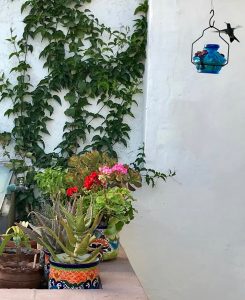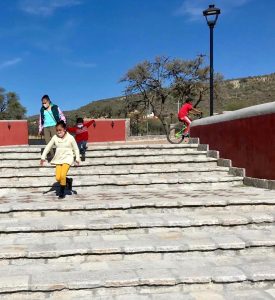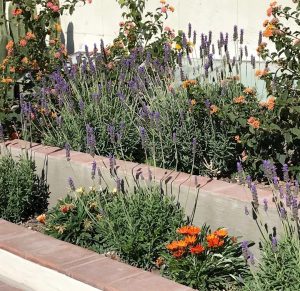Here in San Miguel de Allende, in the central mountains of Mexico, the weather in what passes for “winter” is, in my five-year experience, perfecto. So I must add this to the long list of reasons I’m grateful to live here. Most afternoons these days the temperature outdoors is at or near 72 degrees F. (22 C.): comfy room temp — which, in my opinion, is ideal.

The sky is almost always a solid, cloudless, brilliant blue. The wind is negligible. The sun is embracingly warm, seldom smotheringly so. The spring and summer rains are months away. Flowering plants bloom in everyone’s lovingly tended gardens. Winter snow? Oh, no. (And, I would add, Thank God.)
The weather I left when I came down to “Old” Mexico from northern New Mexico to retire was, for me, nearly unbearable six months of the year. As much as I loved Taos for other reasons, from October to April I’d be climatically miserable. Simply put, I’m just not built for the cold. I’m sadly deficient in bodily insulation.
Added to which, to save money on expensive heating bills, I stubbornly maintained my apartment’s thermostat at 60 degrees (F.) throughout my winters in northern New Mexico, when outdoor thermometers read below zero and snow was often up to my knees. Not surprisingly, pneumonia ensued.
What a contrast this was to the climate I’d experienced in Africa for five years prior to returning to the States.
Living in Ségou, Mali, West Africa, “a stone’s throw” from the Sahara, from 1998 to 2001 was like living in an oven. As I described it in my Mali memoir, How to Make an African Quilt, “The sun there, in a yearlong loop of endless summer, sizzled everything within its grasp, paralyzing living things with its inhumane heat.
“During the day, both men and women wore traditional, long, loose-fitting, tent-like clothing they called boubous and turban-like head wraps to protect themselves from the sun’s fierce rays and the wind’s stinging swipes. Then at night, while the sun went elsewhere and the wind shriveled to an occasional limp breeze, most Malians slept outdoors on straw mats dotting their wall-enclosed compounds, under the moon and the star-studded sky.”
What Malians call their “winter” I came to call “the tourist season” because during these months (December through February) the temperature drops from its standard 115 degrees F. (46 C.) to a more-tolerable-for-foreigners daytime temperature of 85 to 90 degrees F. (29 to 32 C.). For the people of Ségou, who bundle themselves up in ski jackets, woolen caps and scarves during these months, this so-called winter weather is cold. To me it was lifesaving.
When I served in the Peace Corps from 1996 to 1998 in Gabon, a small country straddling the equator, I experienced an altogether different kind of African climate. Gabon is mostly tropical rainforest, with year-round 100-degree (F.) temperatures, close to 100 percent humidity, and an average annual rainfall of more than 120 inches. The driest months are June, July, August, and early September. The rest of the year is muggy and scorching, with heavy rains from evening until morning.
Sometimes during my two years there, in the middle of the thick rainforest, I’d fantasize that if I had a television set, and if there were a local news program on it, its weather-forecast segment would be the same every day: “hazy, hot, and humid” – not unlike the sweltering dog days of August I remembered from my childhood in New Jersey.
This imaginary TV station would not even need a real person, a meteorologist, to make this forecast; they could use a tape recording and play it over again each day: “Today you can expect white-gray, overcast skies; thick, wet air; and insufferable heat.”
The midday heat, I saw and felt at my post in Lastoursville, is so paralyzing everything stops: Children go home from school, and offices and shops close from noon until three. All you can do is lie, immobile, spread-eagle on a bed beneath mosquito netting (if you’re lucky enough to have mosquito netting) and sweat yourself into a siesta (nap) after eating lunch.
So at the risk of sounding Goldilocksian, I must say I find the climate here in San Miguel “just right” — especially now, in the winter. I may like to think of myself as a citizen of the world; but, frankly, at this stage of my life I prefer to remain in a part of the world that feels to me like a comfy room – with an adjoining garden always in bloom.





